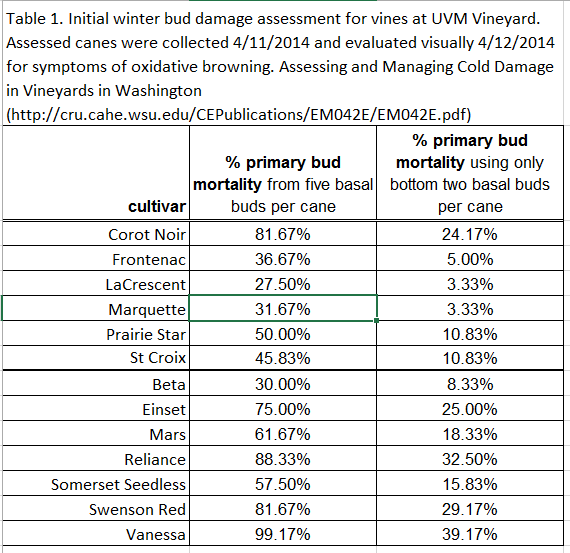April 3, 2014
Terence Bradshaw, UVM Tree Fruit and Viticulture Specialist
I am forwarding this from the Northern Grapes Project mailing list. LOTS of great information to consider as you get into your dormant pruning. In cold years like this one, it is critical to do some bud counts before pruning. -TB

News You Can Use
The Northern Grapes Project is starting a new outreach effort, created at the request of our Project Advisory Council. News You Can Use will provide you with brief, timely information, generated via research conducted as part of the Northern Grapes Project, as well as material derived from other sources. News You Can Usewill be published around the first of every month, and will be sent via email and posted on the project website and Facebook pages. Please let us know what you think!
Assessing Bud Injury and Adjusting Pruning
After the extreme cold temperatures much of the US experienced this winter, many grape growers are concerned about winter injury to buds and trunks. Here in the Finger Lakes region of New York, for example, up to 90% of the primary buds on some V. vinifera cultivars were killed.
Cold-hardy University of Minnesota and Swenson cultivars can withstand much colder temperatures than most other grapes, but it’s still advisable to assess your grapes for winter damage before pruning, and adjust your bud number accordingly. If more than 20% of the buds are dead, you’ll want to leave more buds to maintain a normal cropping level.
Here are some online resources to explore to learn more about how to assess winter injury and manage winter-damaged vines.
Assessing Winter Cold Injury to Grape Buds
Cornell University, Pool and Martinson
(http://www.fruit.cornell.edu/grape/pool/winterinjurybuds.html)
Includes photos of live vs. dead buds, information on how many extra buds to leave when pruning, and links to videos that explain how to evaluate bud damage.
Evaluating Bud Injury and Adjusting Pruning
Cornell University, Martinson
(http://blogs.cornell.edu/nnygrapeupdate/2014/02/28/evaluating-bud-injury-and-adjusting-pruning/)
Blog post with instructions for assessing damage and managing damaged vines.
Cold Injury in Grapevines
eXtension.org, Chien and Moyer
(http://www.extension.org/pages/63372/cold-injury-in-grapevines#.UzwTDPldWJc)
Includes photos of damaged buds and trunks, as well as links to other good resources.
Evaluating Grape Bud Damage Prior to Winter Pruning
Colorado State University, Caspari and Larsen
(http://agronomy.unl.edu/c/document_library/get_file?uuid=912db951-022b-487e-9823-fbb8b5835523&groupId=4128273&.pdf)
This document has photos of the same bud as a series of cuts is being made. This will help you learn what’s too shallow, what’s just right, and what’s too deep.
Ohio Grape-Wine Electronic Newsletter, Special Issue 17 January 2014
Ohio State University, Dami
(http://www.oardc.ohio-state.edu/grapeweb/images/OGEN_17_Jan_2014_Dami.pdf)
Contains information on how to assess for bud damage, how to adjust pruning, and links to other resources. Also includes the article “Pruning Grapevines after Winter Injury” that Dr. Imed Dami wrote for “Wines and Vines” trade magazine a few years ago.
Anatomy of Grapevine Winter Injury and Recovery
Cornell University, Goffinet
(http://www.hort.cornell.edu/goffinet/Anatomy_of_Winter_Injury_hi_res.pdf)
This is a long, and quite technical paper, but has a lot of good photos and in-depth information, including how vines are constructed, what tissues are susceptible to cold, the process of vine cold acclimation, a description of cold injury in the various organs, and the mechanisms the vine uses to heal (if possible) cold-injured structures.
Chrislyn A. Particka, PhD
Extension Support Specialist
Cornell University
Department of Horticultural Sciences
630 W. North Street
Geneva, NY 14456
cap297
315-787-2449 (desk)
315-787-2216 (fax)
www.northerngrapesproject.org
Where trade names or commercial products are used for identification, no discrimination is intended and no endorsement is implied.
Always read the label before using any pesticide.
The label is the legal document for the product use.
Disregard any information in this newsletter if it is in conflict with the label.
The UVM Tree Fruit and Viticulture Program is supported by the University of Vermont Agriculture Experiment Station, a USDA NIFA E-IPM Grant, and USDA Risk Management Agency Funds.

